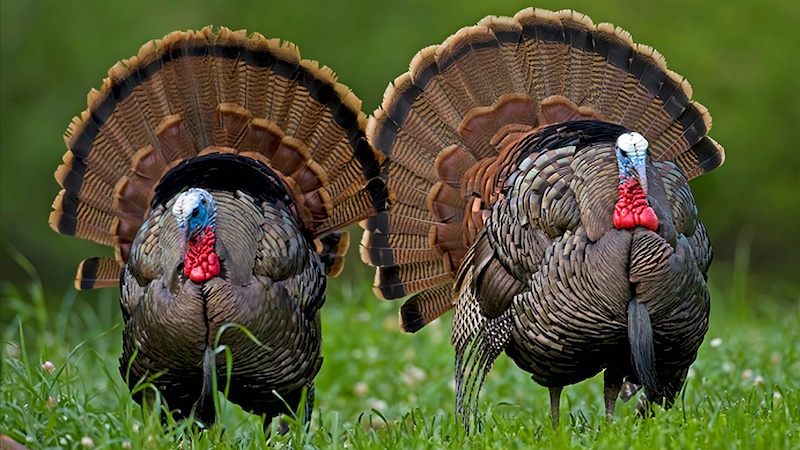It’s fascinating to trace the wild turkey’s journey from being domesticated by Native Americans a thousand years ago to its role in the antebellum era at Elizabeth and Berners Barnwell Sams’s table on Datha Island and, ultimately, to its place on our Thanksgiving tables today. It’s a journey worth reflecting on as you enjoy your holiday feast.
Picture your Thanksgiving turkey—wild or domestic. They might share genes, but that’s where the similarities waddle away. Wild turkeys are like the Usain Bolt of the bird world, sprinting faster than a horse and flying over a mile at 55 mph. In the 18th century, 10 million turkeys roamed the United States’s eastern region. The big birds played a vital role in the physical and spiritual well-being of our country’s early inhabitants. Wild turkeys are a conservation success story in South Carolina, thanks to efforts by the S.C. Department of Natural Resources and others. [See SDNR article here.]
Native Americans were the original turkey domesticators a thousand years ago. Domesticated turkeys got plump through selective breeding, losing their ability to fly and becoming slower on land. Turkeys were raised in Mexico and Central America for more than 500 years before the Spanish arrived. Spanish explorers then took Aztec-domesticated turkeys to Europe in the 1500s, and these birds crossed the Atlantic again with colonists. The story of the Pilgrims and the Wampanoag at the first Thanksgiving in 1621 often includes references to turkey as one of the main dishes served.
The turkey took on a cultural significance as the British colonists arrived in significant numbers in later centuries. Benjamin Franklin preferred the wild turkey over the eagle to symbolize our American identity. In a letter to his daughter, written in 1784, Franklin expressed his views on the bald eagle as a bird of “bad moral character” because it tended to steal fish from other birds and its association with scavenging. On the other hand, he spoke highly of the turkey, describing it as a “much more respectable bird” and a “true original native of America.” Franklin admired the turkey for its resourcefulness, adaptability, and representation of a genuine American species.
Antebellum Thanksgiving on Datha
In the antebellum period in America, turkey consumption was widespread and an integral part of the diet. Englishman Adam Hodgson, writing about his journey through North America, mentioned in 1819 that he couldn’t recall a day without turkey on the table. Additionally, the tradition of explicitly serving turkey for Thanksgiving began in the antebellum period. William Bentley of Salem, Massachusetts, emphasized in 1806 that a Thanksgiving celebration was incomplete without a turkey. Which brings me to Dr. Berners Barnwell Sams. Both gentlemen talked about an era in which BB Sams was building his plantation house on Datha Island and starting a family. I am confident that the Sams on Datha Island, at least at BB Sams’s Datha Inlet plantation, celebrated many Thanksgivings that featured turkey. Why? Because his daughter wrote about it.
Elizabeth Fripp married Dr. Berners Barnwell Sams at 17 in 1812. Together they had eleven children. Elizabeth died at age 35 while giving birth to their daughter, Elizabeth Exima Sams, in 1831. Daughter Elizabeth was 24 when her father died. Fortunately, daughter Elizabeth lived a long life in South Carolina. She probably enjoyed good health because, late in life, she traveled from Beaufort, South Carolina, to Norfolk, Virginia, to visit her nephew, Conway Whittle Sams (1864 – 1935). Elizabeth Exima Sams (1831 – 1906) passed along an oral history of her father to Conway, who wrote it down and had her sign it during the visit. You can read more about her reflections here.
As for turkeys, Elizabeth had this to say about the farming products of Datha Island:
On the place [i.e., Datha Island], besides the cotton which was raised for sale, there was grown for home consumption corn, peas, potatoes, turnips, sugar- cane, tanyas, a vegetable like a turnip, pomegranates, pears of every variety, different varieties of figs, apples, ground nuts, black walnuts, persimmons, bitter-sweet oranges, cattle, pork, chickens, geese, ducks, guinea fowls, turkeys, in large quantities, and sheep.
Elizabeth E. Sams circa 1905
As you enjoy your Thanksgiving turkey, please take a moment to appreciate the wild turkey’s resilience and its fascinating journey from its domestication by Native Americans to its presence on the Thanksgiving table of Dr. Berners Barnwell Sams and Elizabeth Fripp Sams plantation (Datha Inlet) during the antebellum era to gracing our holiday tables today.
Sources
S.C. Department of Natural Resources – SDNR News
Wikipedia – Cuisine of Antebellum America
Smith, Andrew F. – The Turkey: An American Story. Chicago: University of Illinois, 2006.
Hodgson, Adam – Remarks During a Journey Through North America in the Years 1819, 1820, and 1821, New York: Samuel Whiting, 1823


